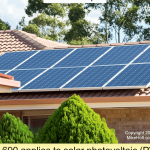Photo courtesy of Independent Solar
Opinions expressed by Digital Journal contributors are their own.
Installing solar panels can save consumers money and reduce harmful emissions that pollute our air and fuel climate change. But in just about every case, the customers who buy from my company, Independent Solar, view all solar panels as being effectively the same. The way they see it, the particular brand doesn’t matter — they all achieve the same result.
The problem here is that customers overlook a critical consideration: where the panels come from.
Independent Solar has been around for 20 years. There are very few companies doing solar that are 20 years old. I’ve been in this industry a long time, but I’ve never seen a crisis like the one the United States solar industry is headed toward now.
Until fairly recently, most of the solar panels bought by U.S. homeowners were made here in America. But like many other industries, the solar industry has begun to rely on products imported from China. In 2023, the U.S. imported a record number of Chinese solar panels — 54GW worth, to be exact. That’s an 82% increase from 2022.
Why the sudden change? Much of it comes down to 2022’s Inflation Reduction Act (IRA).
Most consumers know that the IRA incentivizes individual consumers to invest in solar panels, electric cars, and other sources of clean energy. Some know that it provides an incentive for domestic solar manufacturers. However, few know that it heavily subsidizes Chinese solar manufacturers.
As you might have guessed, even with incentives in place, American solar manufacturers are being squeezed out by their Chinese counterparts. In our space, the regulatory winds are flowing — but the one thing they aren’t regulating is where the solar panels come from. China is able to set extraordinarily low prices on its solar panels, and the U.S. simply can’t compete.
That probably sounds like a self-contained issue that only has negative effects on domestic solar panel manufacturers. Unfortunately, it has far-reaching consequences. More specifically, it threatens U.S. job growth, jeopardizes the country’s energy security, and causes more harm to the environment.
Solar power was innovated in the United States, and its growth has created well-paying jobs at every level of the process (from manufacturing to installation). The solar panel supply chain is lengthy and complex, so keeping the process within our country leads to gainful employment for more Americans.
As of 2022, there were 263,883 jobs in the U.S. that primarily focused on solar energy. If more domestic businesses take advantage of the tax credits and other incentives laid out in the IRA, that number will certainly grow.
Conversely, if domestic manufacturers keep losing business to Chinese importers, many of those jobs will disappear. There will still be a need to install imported panels, but every step of the supply chain and the assembly process will be (primarily) limited to China.
Hindered job growth is the first thing that comes to mind for many people when they think of keeping much of the solar supply chain in China. However, relying almost exclusively on China (or any other country, for that matter) for solar energy can pose a security threat.
One of the most surprising disadvantages of shifting solar panel production to China: it’s actually much worse for the environment.
One study found that manufacturing solar panels in China created 30% more greenhouse gasses than manufacturing them in the U.S. That’s because a large portion of Chinese electricity comes from burning coal.
This all might make it sound like solar has a gloomy future. Fortunately, it doesn’t, and that’s thanks to the Solar Energy Manufacturers for America (SEMA) Coalition.
The SEMA Coalition is a group of solar manufacturers with a unified goal: to rebuild the solar energy supply chain in the United States. Its members hope that the rebuilt supply chain will save U.S. solar customers money on their utility bills, create clean energy, open up new job opportunities, and make the country energy-independent.
That’s not just talk. The coalition has already made a change for the better in the world of domestic solar manufacturing. Its members advocated for Solar Energy Manufacturers for America tax credits and other incentives to be included in the Inflation Reduction Act. The SEMA Coalition was successful — you can find these incentives in section 45X of the IRA.
The SEMA Coalition has taken the lead in that venture. But U.S. solar (and solar-adjacent) companies can help, too. Independent Solar is responsible for making our consumers aware of the current crisis and helping them understand why investing in American solar energy is so important.
It would be misleading to say that the panels sold are the cheapest on the market. They aren’t. But customers care about the environment, so we’ll tell them how buying U.S.-made panels cuts down on greenhouse gas emissions. They care about other people, so we’ll let them know how an all-American supply chain will create meaningful jobs that pay well.
The American solar industry has always been about innovation. Maintaining that spirit allows not only to keep the solar supply chain within the borders but also to create a solar product that is competitive on a global scale.
This post was originally published on 3rd party site mentioned in the title of this site





